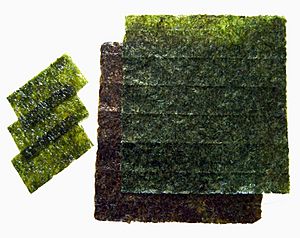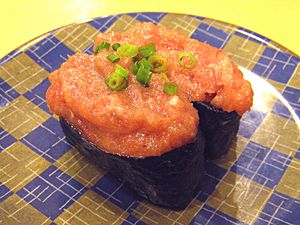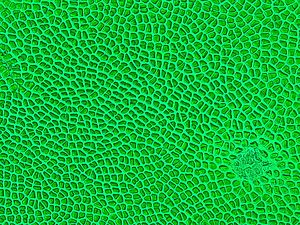Nori facts for kids

Nori sheets
|
|
| Type | edible seaweed |
|---|---|
| Main ingredients | dried red algae |
| Similar dishes | Gim |
Nori (海苔) is a type of dried edible seaweed. It is very popular in Japanese cuisine. Nori is made from a kind of red alga called Pyropia. Two common types are P. yezonesis and P. tenera.
Nori has a unique and strong flavor. You often see it used to wrap sushi rolls. It is also used for onigiri, which are Japanese rice balls.
To make dried nori sheets, the seaweed is shredded. Then it is spread out and dried on racks. This process is a lot like how paper is made. You can buy nori sheets in packs at grocery stores. It's important to store nori with a desiccant. This is because nori sheets can easily soak up water from the air. If they get wet, they won't be as good.
Contents
History of Nori
Long ago, the word nori was used for many different kinds of seaweed. One of the first times nori was written about was around the 700s. In the year 701, a law called the Taihō Code was created. This law said that nori could be used as a form of tax!
Ancient writings from the 700s also talk about people drying nori. They mention harvesting nori in different parts of Japan. This shows that nori has been a food for a very long time. Around the year 987, a story called Utsubo Monogatari mentioned nori as a common food.
For many years, nori was eaten as a paste. But around 1750, in a city called Edo (which is now Tokyo), something new happened. People started making nori into thin sheets. They used a method similar to how Japanese paper is made.
The word "nori" first appeared in an English book in 1796. It was used to describe "Awa nori," which is probably what we now call aonori.
After World War II, Japan needed more food. The production of nori was going down. People tried to grow nori on farms instead of just collecting it from the sea. But they didn't understand how nori grew.
Then, a British scientist named Kathleen Mary Drew-Baker helped. She studied a similar type of seaweed in Wales. Her work helped Japanese scientists understand nori's life cycle. This knowledge helped them grow nori artificially. Kathleen Baker became known as the "Mother of the Sea" in Japan. There is even a statue built to honor her. She is still seen as the person who saved the Japanese nori industry.
Today, the Japanese nori industry faces new challenges. There is more competition from seaweed growers in China and Korea. Also, a sales tax increase in Japan has affected sales.
In the 1960s, nori became more popular in the United States. It was sold in health food stores. In the 1970s, with more sushi bars opening, nori became even more common.
How Nori is Made
Making and processing nori is like a special kind of farming. Scientists now understand how Pyropia seaweed grows. This helps them control the whole process.
Nori farms are in the sea. The Pyropia plants grow attached to nets that float on the water. Farmers use boats to work on these farms. The plants grow very fast. It takes about 45 days from when they are "planted" until the first harvest. Farmers can harvest the seaweed many times from the same plants, usually every ten days or so. Machines are used to collect the seaweed.
After harvesting, the raw seaweed is processed. Big, automated machines do most of the work. They copy the old hand-made steps but are much faster and more consistent. The final product is a thin, black, dried sheet. Each sheet is about 18 by 20 centimeters (7 by 8 inches) and weighs about 3 grams.
You can find different qualities of nori. The most common types come from China and are less expensive. The best quality nori is called "delicate shin-nori." This nori comes from the first harvest of the year. It is grown in the Ariake Sea in Japan. This high-quality nori can be much more expensive.
In Japan, over 600 square kilometers (230 square miles) of ocean are used to grow nori. They produce about 350,000 tons of nori each year. This is worth more than a billion dollars! China produces about one-third of this amount.
How Nori is Used in Cooking

Nori is most often used to wrap sushi and onigiri (rice balls). It is also used as a topping or flavor in noodle dishes and soups. Usually, nori is toasted before you eat it. This is called yaki-nori.
Another popular type is flavored nori, called ajitsuke-nori. This nori is toasted and has a special flavoring mixture added. This mixture often includes soy sauce, sugar, sake, and mirin.
Nori can also be made into a soy sauce-flavored paste. This paste is called nori no tsukudani (海苔の佃煮). Sometimes, nori is even used to make food look pretty as a decoration.
A similar product is aonori (青海苔). This is made from a different kind of green seaweed. Aonori is often sprinkled like an herb on everyday Japanese meals. You might see it on okonomiyaki or yakisoba.
Nori and Your Health
Raw seaweed is mostly water (85%). It also has some protein (6%) and carbohydrates (5%). It has very little fat.
If you eat 100 grams of seaweed, it gives you a lot of important vitamins. It is a great source of vitamin A, vitamin C, riboflavin, and folate. Seaweed also provides some niacin, iron, and zinc.
Nori has a lot of iodine. Just one gram can give you a good amount of this important mineral. Some studies in 2014 said that dried nori has enough vitamin B12 to meet your daily needs. However, other studies in 2017 were not so sure. They suggested that vitamin B12 might change or be lost when nori is dried and stored. The Academy of Nutrition and Dietetics said in 2016 that nori is not a good source of vitamin B12 for people.
Similar Foods
Other types of red algae are eaten in different parts of the world. In Korean cuisine, a similar food is called gim. In Wales and Ireland, a food called laverbread is made from a similar seaweed.
See also
 In Spanish: Nori para niños
In Spanish: Nori para niños




